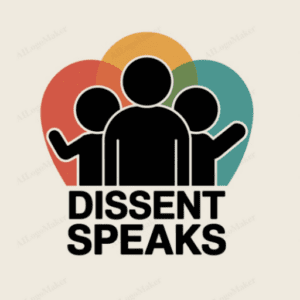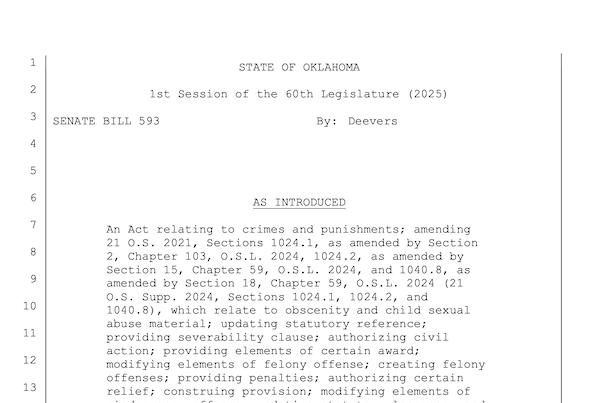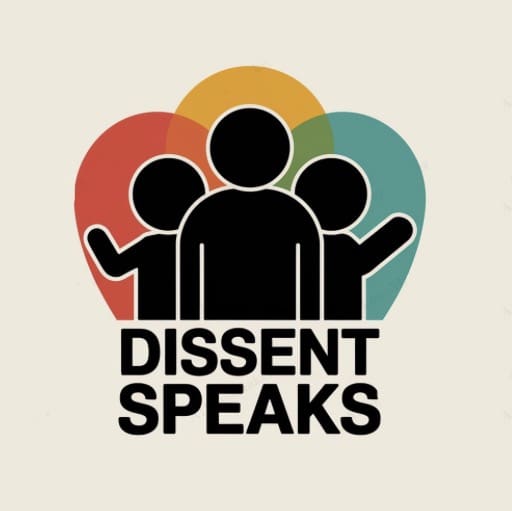Oklahoma Senate Bill 593, introduced in the first session of the 60th Legislature for 2025, presents itself as legislation aimed at protecting children from exploitation. However, a careful analysis reveals concerning language and potential applications that could extend far beyond its stated purpose, raising significant questions about civil liberties and constitutional rights.
The Spirit vs. Letter of the Law
While the bill’s primary focus appears to be protecting minors from exploitation, its broad definitions and enforcement mechanisms create a framework that could potentially be used to regulate a wide range of constitutionally protected speech and expression. Legal scholars have noted that such expansive language in legislation can lead to unintended consequences when applied in real-world situations.
“The danger lies not in what the law explicitly states, but in how it could be interpreted and applied,” explains Constitutional law expert Sarah Martinez from the Civil Rights Law Center (“Legal Analysis of State Censorship Laws”, https://www.civilliberties.org/research). “When legislation includes broad definitions and severe penalties, it can create a chilling effect on protected speech.”
Concerning Elements and Potential Impacts
1. Broad Definitions and Vague Standards
The bill defines “unlawful pornography” using subjective standards that could encompass a wide range of material, including:
- Content that “appeals to prurient interest” based on “contemporary community standards”
- Material lacking “serious literary, artistic, educational, political, or scientific purposes”
- Visual depictions that could be interpreted as “lewd exhibition”
These definitions rely heavily on subjective interpretation, which legal experts warn could lead to inconsistent enforcement and potential abuse (American Civil Liberties Union, “State Censorship Laws Report 2024”, https://www.aclu.org/reports).
2. Private Right of Action
One of the most concerning aspects is the creation of a private right of action, allowing any person (except government employees) to bring civil suits against alleged violators. This provision includes:
- Minimum statutory damages of $10,000 per image
- No cap on total damages
- Mandatory attorney fees for prevailing plaintiffs
- No attorney fees allowed for prevailing defendants
“This structure creates a powerful financial incentive for private litigation that could be used to harass or intimidate content creators,” notes media law attorney James Wilson (“Digital Rights and Content Creation”, https://www.medialaw.org/analysis).
3. Severability Clause Implications
The bill’s extensive severability clause suggests awareness that portions may be found unconstitutional, yet it attempts to preserve maximum enforcement power even if key provisions are struck down. This approach could lead to:
- Fragmented enforcement
- Inconsistent application across jurisdictions
- Continued chilling effects even after successful constitutional challenges
Beyond Child Protection: Potential Applications
While the law’s stated purpose centers on child protection, its framework could potentially be applied to:
- Adult Content Creators: The broad definitions could impact legitimate adult content creators through civil litigation.
- Artists and Photographers: Works dealing with the human form could face challenges under the “contemporary community standards” test.
- Educational Materials: Sex education or medical content could be targeted under certain interpretations.
- Digital Platform Operators: Websites and platforms could face pressure to over-censor to avoid liability.
Constitutional Concerns
Legal experts have identified several potential constitutional issues:
- First Amendment Conflicts: The bill’s broad definitions could encompass protected speech.
(“First Amendment and Content Regulation”, Georgetown Law Review, https://www.law.georgetown.edu/research) - Due Process Concerns: The combination of severe penalties and vague standards raises due process questions.
- Commerce Clause Issues: The law’s reach could affect interstate commerce in ways that exceed state authority.
Actionable Steps for Concerned Citizens
- Stay Informed
- Monitor the bill’s progress through the legislature
- Follow legal challenges and court interpretations
- Join civil rights organizations tracking these issues
- Engage with Legislators
- Contact your representatives
- Attend public hearings
- Submit written testimony
- Document Impacts
- Report instances of overreach
- Maintain records of any negative effects
- Share experiences with advocacy groups
- Support Legal Challenges
- Contribute to legal defense funds
- Provide testimony when needed
- Share relevant expertise
Conclusion
While protecting children from exploitation is an undeniably crucial goal, Senate Bill 593’s broad language and enforcement mechanisms create potential for application far beyond this purpose. The combination of vague standards, severe penalties, and private enforcement mechanisms could lead to significant chilling effects on protected speech and expression.
As this legislation moves forward, careful monitoring and potential legal challenges will be essential to ensure that legitimate rights are protected while maintaining effective tools against actual exploitation.
This analysis is based on current legal scholarship and expert opinions. For the most up-to-date information, consult with legal professionals or civil rights organizations.


